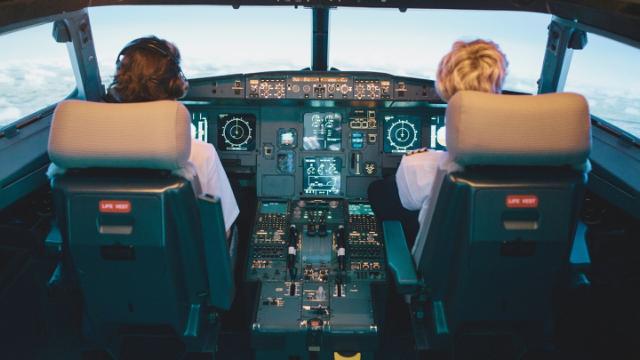
Fight, Flight, or Freeze: How Does Your Body React to Stress?
Aviation is a stressful industry. Pilots, cabin crew, and maintenance staff must deal with stress every day, but their reactions to stress may manifest in different ways. Dive into the three most common reactions to stress and discover how they affect the body.
When you experience an unknown situation, your mind will perceive this as danger or as a threat, and your body will respond with involuntary physiological changes. This happens because you go into a full state of alert. To counter this threat, your body will either FIGHT, FLEE or FREEZE.
This article explores the ‘fight’, ‘flight’, or ‘freeze’ responses in greater detail – and provides examples of how aviation professionals are affected by stress.
A Life-Threatening Event?
You may think that the fight, flight, or freeze responses are only activated when you experience serious threats to your life. However, stress responses also manifest in everyday situations such as making decisions during adverse weather, taking care of an ill passenger, or performing a critical task in the maintenance workshop.
When you experience stress, you may react in one of three ways:
- You fight the threat at hand
- You flee the situation and disengage
- You freeze and become immobile
Different situations may generate different responses – but continuous training in safety and stress management prepares you for all types of situations. Whether your body decides to fight, flight, or freeze, the goal is SURVIVAL. But the reaction is beyond your control.
Breaking Down the Bodily Reactions
Every stressful situation affects the body. When you perceive a threat, the amygdala sends signals to your brain. The amygdala is a tiny part of your brain which helps you feel and react to emotions and stimuli such as fear. The amygdala can be described as your brain’s alarm system which is triggered during stress.

The amygdala is responsible for sending signals to other organs in your body, thus activating the fight, flight, or freeze response.
The stress responses will inevitably affect your body. You may experience:
- Increased heartrate
- Rapid or slowed breathing
- Involuntary perspiration and excessive sweating
- Hot or cold flashes
- Paleness or flushed skin
- Muscle tension and dry mouth
- Dizziness or light-headedness
- Shortness of breath
- Shaking limbs
The fight and flight reactions share similar symptoms, and you may feel more alert or agitated. In contrast, the freeze response triggers physical immobility, making you unable to move and act.
Read more: Stress, Fatigue, and Pressure: How to Cope?
When Stress Enters the Cockpit
Every pilot has faced a stressful situation in the cockpit. To counter the negative consequences of stress on performance, decision-making, and safety, pilots receive extensive training.
Over time, the training helps the brain recognise and identify potentially threatening situations as a non-threat. The training thus contributes to limiting the reaction time in stressful situations. So pilots can analyse, decide, and act – instead of just react.

However, the fight, flight, or freeze responses are not something you actively choose in a given situation. They are essentially instinctive reactions stemming from our reptilian brain. If – and only if – we manage to leave the state of reaction, our cerebrum helps us come up with potential solutions and actions which mitigate or resolve the perceived threat and danger.
Our amygdala must perceive a new situation as ‘non-threatening’ or ‘non-dangerous’ before the cerebrum is activated. Only then can we act instead of react.
Read more: The Human Factor: When Humans Make Mistakes...
Aviation professionals are often able to abandon the reaction state more quickly due to their extensive training in safety, emergency, and procedures.
But there are no guarantees. Stress responses are after all involuntary physiological safeguards. Still, training and experience are crucial to managing stressful situations effectively.
Explore Our World of Active Learning
Get acquainted with MAYDAY - an interactive training solution for the global aviation industry.
Dealing with Stress in the Hangar
Similar to a cockpit, the maintenance workshop constitutes a stressful work environment. Avionics technicians, aircraft mechanics, and the like, may feel stressed due to time constraints, long shifts, or unexpected issues they encounter while performing maintenance or repair on an aircraft.

Like pilots, the kings of the hangar are trained to handle stress. However, we cannot train every potential threat or situation which entails danger.
During training, aviation professionals are exposed to unknown or unfamiliar situations in order to, hopefully, minimise the time in which the body reacts with fight, flight, or freeze. The training essentially enables them to better tackle perceived dangers.
Read more: Diving into the Dirty Dozen: Limit the Impact and Improve Safety
Training in Stress Management
Stress responses significantly vary depending on training, experience, and resilience. Aviation places strong emphasis on stress management and situational awareness through extensive training programmes, standardised procedures, and strong safety cultures. This helps to develop resilience and enables aviation professionals to cope better with dangerous situations. These factors contribute to limiting the negative impact of stress on human performance.
Essentially, thorough training enables the brain to recognise a dangerous situation or threat – and helps the brain choose the proper stress response. Only then can we think, analyse, and act accordingly.
How are you dealing with stress in your organisation?



